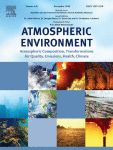Iavorivska et al., 2016
Atmospheric deposition of organic carbon via precipitation
Iavorivska L, EW Boyer, and DR DeWalle (2016)
Atmospheric Environment, vol 146, p. 153-163
-
Boulder, Christina, Luquillo, Shale Hills, Sierra, INVESTIGATOR
Abstract
Atmospheric deposition is the major pathway for removal of organic carbon (OC) from the atmosphere, affecting both atmospheric and landscape processes. Transfers of OC from the atmosphere to land occur as wet deposition (via precipitation) and as dry deposition (via surface settling of particles and gases). Despite current understanding of the significance of organic carbon inputs with precipitation to carbon budgets, transfers of organic matter between the atmosphere and land are not explicitly included in most carbon cycle models due to limited data, highlighting the need for further information. Studies regarding the abundance of OC in precipitation are relatively sparse, in part due to the fact that concentrations of organics in precipitation and their associated rates of atmospheric deposition are not routinely measured as a part of major deposition monitoring networks. Here, we provide a new data synthesis from 83 contemporary studies published in the peer reviewed literature where organic matter in precipitation was measured around the world. We compiled data regarding the concentrations of organic carbon in precipitation and associated rates of atmospheric deposition of organic carbon. We calculated summary statistics in a common set of units, providing insights into the magnitude and regional variability of OC in precipitation. A land to ocean gradient is evident in OC concentrations, with marine sites generally showing lower values than continental sites. Our synthesis highlights gaps in the data and challenges for data intercomparison. There is a need to concentrate sampling efforts in areas where anthropogenic OC emissions are on the rise (Asia, South America), as well as in remote sites suggesting background conditions, especially in Southern Hemisphere. It is also important to acquire more data for marine rainwater at various distances from the coast in order to assess a magnitude of carbon transfer between the land and the ocean. Our integration of the recent published information on OC in precipitation provides a unique data set (shared here as supplemental information) and a regional perspective that will be useful in carbon budgets, environmental modeling, and ecosystem studies. This can be used for comparison with past conditions and as a baseline toward exploring future changes, since changes in emissions, land use, and climatic variability are reflected in the amount and quality of OC deposited to ecosystems.
Citation
Iavorivska L, EW Boyer, and DR DeWalle (2016): Atmospheric deposition of organic carbon via precipitation. Atmospheric Environment, vol 146, p. 153-163. DOI: 10.1016/j.atmosenv.2016.06.006
Explore Further


